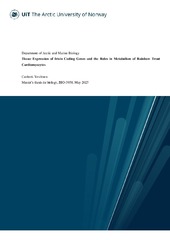Tissue Expression of Irisin Coding Genes and the Roles in Metabolism of Rainbow Trout Cardiomyocytes
Author
Yesilmen, CanberkAbstract
Fndc5 is the precursor to irisin, a myokine that is believed to contribute to metabolism and growth regulation. Therefore, irisin could potentially have a stimulatory effect on fish growth in aquaculture. However, the expression and physiological role of irisin in fish is largely unknown. This study aimed to increase the understanding of fndc5/irisin in Rainbow trout (Oncorhynchus mykiss) by investigating gene expression of irisin coding genes, heterologous expression of two irisin isoforms followed by evaluation of these isoforms using an in vitro cardiomyocyte cell model.
The spatiotemporal gene expressions levels of the fndc5 genes were analyzed by qPCR. There were differences in the tissue expression of all four genes, and brain had the numerically highest expression levels of fndc5-a1, fndc5-a2 and fndc5-b2 in both 100g and 1kg trout. In addition to brain, skin also showed a higher expression of fndc5-b1 than the other tissues at 100g. Rainbow trout fry showed significantly higher expression levels of all the irisin coding genes, likely due to tissues being mixed for ¼ of whole fish samples from fry.
Furthermore, recombinant production for two isoforms of irisin was conducted with E. coli using pET-28a(+) plasmid The irisin protein produced from isoform B1 was readily soluble, but isoform A1 needed to be treated under denaturing conditions for successful solubilization. The in vitro cardiomyocyte cell s trials revealed that isoform B1 had negative effects on proliferation and toxicity in cardiomyocytes at higher concentrations (10 nM). Isoform A1 also showed increased negative effects at higher concentrations but at a much smaller magnitude. There were no significant effects of the two tested isoforms on mitochondrial respiration (basal or maximal) or gene expression of mitochondrial markers.
Publisher
UiT The Arctic University of NorwayMetadata
Show full item recordCollections
Copyright 2025 The Author(s)


 English
English norsk
norsk
